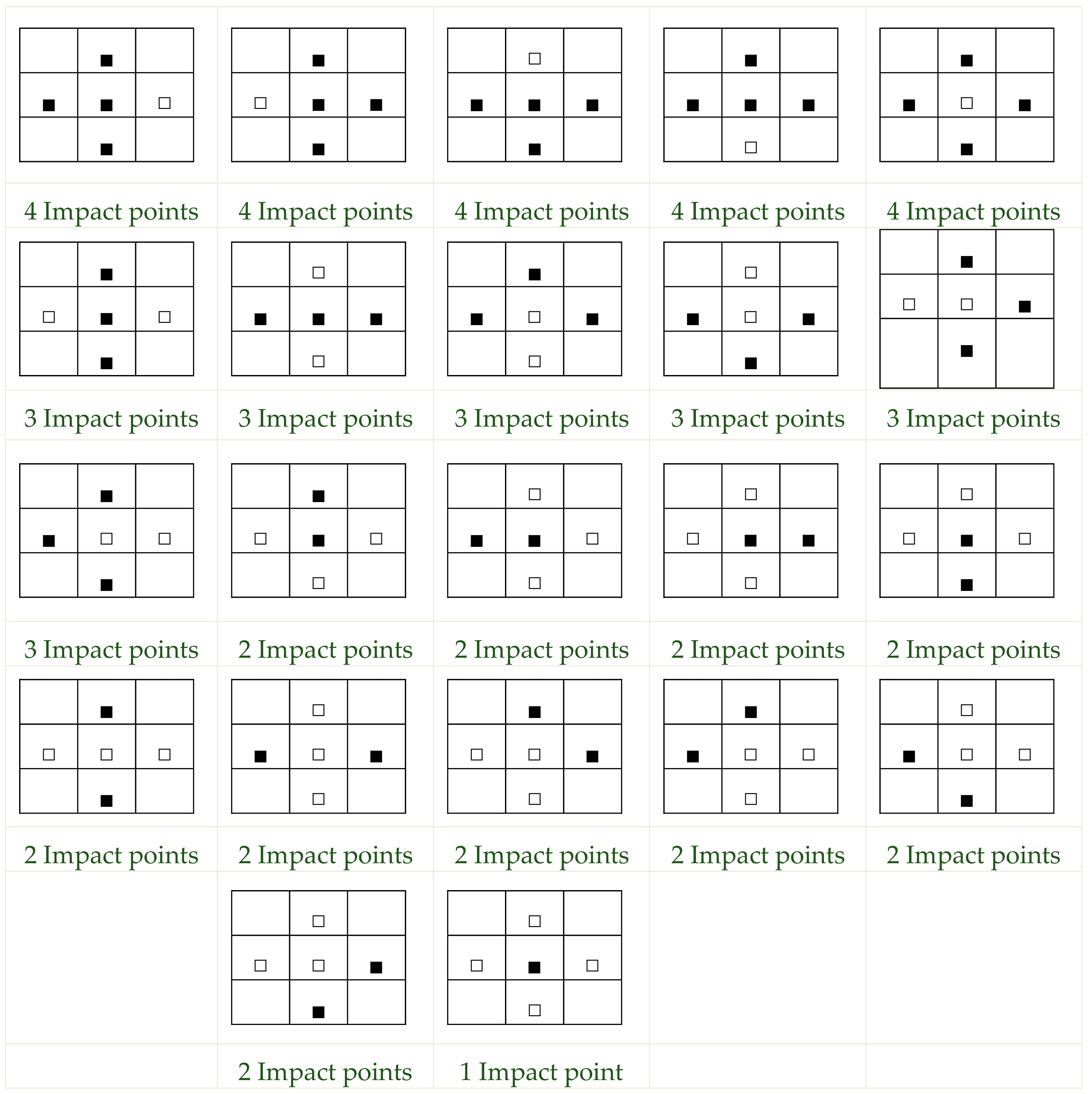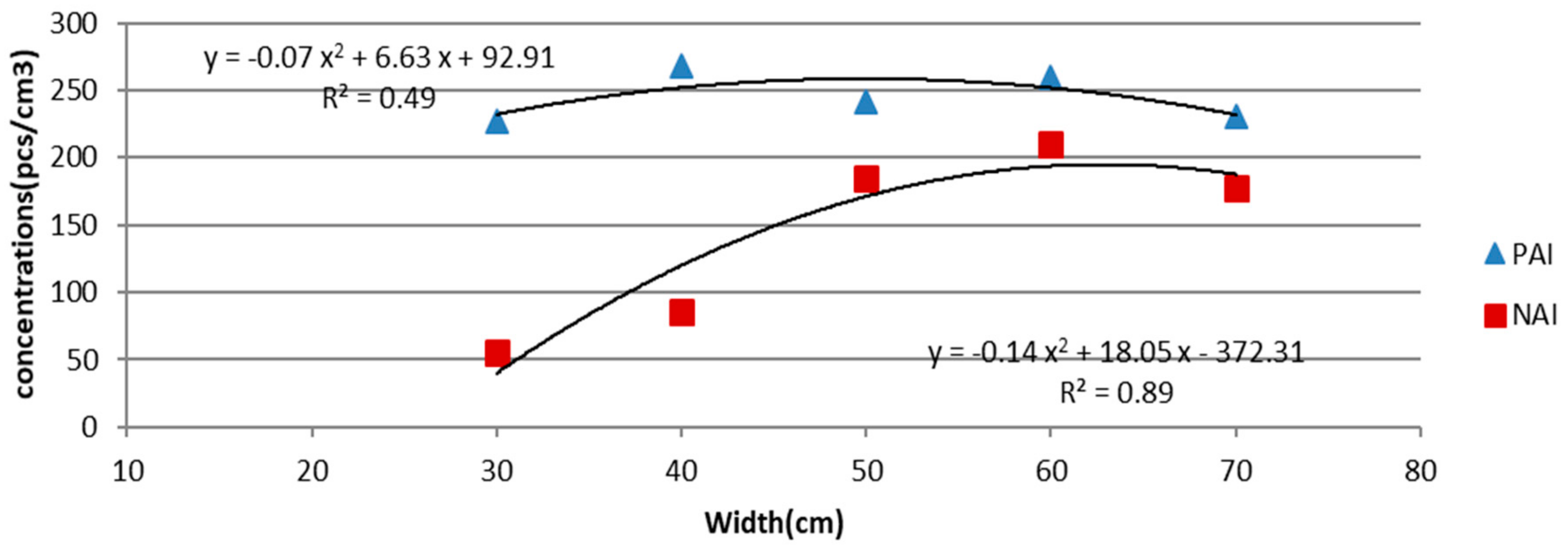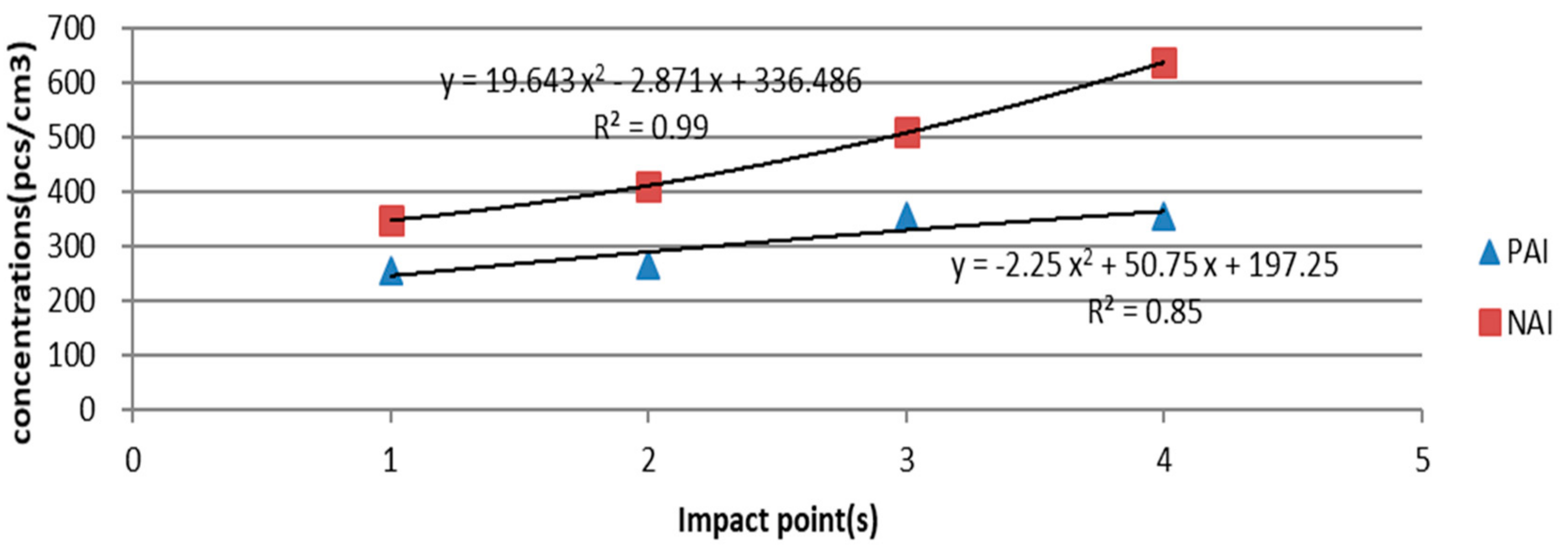Generating Negative Air Ions in Construction Waterscapes at a Garden Scale
Abstract
1. Introduction
2. Material and Methods
3. Results
3.1. NAI and PAI Concentrations Measured at Different Waterfall Heights
3.2. PAI and NAI Concentrations Measured at Different Waterfall Widths
3.3. PAI and NAI Concentrations at Different Waterfall Tiers
3.4. NAI and PAI Concentrations at Different Waterfall Slopes
3.5. PAI and NAI Concentrations at Different Waterfall Impact Points
4. Discussion
4.1. NAI Concentrations Observed for Different Waterscape Designs
4.2. PAI Concentrations Observed for Different Waterscape Designs
4.3. Monopole Coefficients Observed for Different Waterscape Designs
4.4. Analysis of Ion Production and Monopole Coefficient of a Composite Waterscape
5. Conclusions
Author Contributions
Acknowledgments
Conflicts of Interest
References
- Charry, J.M.; Kvet, R. Air Ions: Physical and Biological Aspects; CRC Press: Boca Raton, FL, USA, 1987. [Google Scholar]
- Wu, C.C. Control of Volatile Organic Compounds, Particulates, and Bioaerosols with the Aid of Negative Air Ions in Indoor Environment. PhD Thesis, National Taiwan University, Taipei, Taiwan, 30 June 2006. [Google Scholar]
- Wu, C.F.; Lai, C.H.; Chu, H.J.; Lin, W.H. Evaluating and mapping of spatial air ion quality patterns in a residential garden using a geostatistic method. Int. J. Environ. Res. Public Health 2011, 8, 2304–2319. [Google Scholar] [CrossRef] [PubMed]
- Kosenko, E.A.; Kaminsky, Y.G.; Stavrovskaya, I.G.; Sirota, T.V.; Kondrashova, M.N. The stimulatory effect of negative air ions and hydrogen peroxide on the activity of superoxide dismutase. FEBS Letters 1997, 410, 309–312. [Google Scholar] [CrossRef]
- Liu, M.F. The health benefit of forest recreation. Master’s Thesis, National Taipei University of Nursing and Health Science, Taipei, Taiwan, 30 June 2003. [Google Scholar]
- Wan, Z.N.; Ding, X.D. The effect of minus ion in the air on sports ability and its application in exercise. China. J. Hubei Sports Sci. 2006, 25, 534–536. [Google Scholar]
- Zhao, X.W.; Li, C.Y.; Ge, J.R.; Yang, J.M.; Liu, X.Q. Progress of aero-anion in forest environment. J. Northwest Forestry University 2007, 22, 57–61. (in Chinese). [Google Scholar]
- Wang, C.; Yuan, W.; Lin, X.Y. Air anion level and valuation in major tourist areas of acheng district. Agric. Technol. Informa. Mod. Landsc. Archit. 2007, 10, 45–50. (in Chinese). [Google Scholar]
- Wu, Z.P.; Wang, C. Urban green space and human health. World Forestry Res. 2007, 20, 32–37. (in Chinese). [Google Scholar]
- Shen, J.M.; Rao, S.T.; Wang, L.L. Study on improving effects of negative ion technique on environment in an underground railway station. J. Heat. Vent. Air Cond. 2008, 39, 122–128. (in Chinese). [Google Scholar]
- Huang, W.X.; Xiao, L.H.; Huang, Y.Y.; Lin, X.D. Study on concentrations of air anion in Nanao island. Guangzhou Chemical Industry 2009, 37, 178–181. [Google Scholar]
- Lenard, P. Über die Electrizität derWasserfälle. Ann. Phys. 1892, 46, 584–636. [Google Scholar] [CrossRef]
- Iwama, H. Negative air ions created by water shearing improve erythrocyte deformability and aerobic metabolism. Indoor Air 2004, 14, 293–297. (in Japanese). [Google Scholar] [CrossRef]
- Jiang, S.Y.; Ali, M.; Ramachandran, S. Negative air ions and their effects on human health and air quality improvement. Singapore. J. Mol. Sci. 2018, 19, 2966. [Google Scholar] [CrossRef] [PubMed]
- Altamimi, G.; Illias, H.A.; Mokhtar, N.; Mokhlis, H.; Bakar, A.H.A. Corona discharges under various types of electrodes. In Proceedings of the 2014 IEEE International Conference on Power and Energy (PECon), Kuching Sarawak, Malaysia, 1–3 December 2014; pp. 5–8. [Google Scholar]
- Ogar, V.N.; Bendor, S.A.; James, A.E. Analysis of corona effect on transmission line. Am. J. Eng. Res. 2017, 6, 75–87. [Google Scholar]
- Berendt, A.; Budnarowska, M.; Mizeraczyk, J. DC negative corona discharge characteristics in air flowing transversely and longitudinally through a needle-plate electrode gap. J. Electrostat. 2018, 92, 24–30. [Google Scholar] [CrossRef]
- Sutto, H.C. Superoxide and ozone production by corona discharge. J. Chem. Soc. 1984, 80, 2301–2311. [Google Scholar]
- Berry, D.; Mainelis, G.; Fennell, D. Effect of an ionic air cleaner on indoor/outdoor particle ratios in a residential environment. Aerosol Sci. Technol. 2007, 41, 315–328. [Google Scholar] [CrossRef]
- Niu, J.L.; Tung, T.C.W.; Burnett, J. Quantication of dust removal and ozone emission of ionizer air-cleaners by chamber testing. J. Electrostatics 2001, 51, 20–24. [Google Scholar] [CrossRef]
- Wu, C.C.; Lee, G.W.M. Oxidation of volatile organic compounds by negative air ions. Atmos. Environ. 2004, 38, 6287–6295. [Google Scholar] [CrossRef]
- Waring, M.S.; Siegel, J.A.; Corsi, R.L. Ultrafine particle removal and generation by portable air cleaners. Atmos. Environ. 2008, 42, 5003–5014. [Google Scholar] [CrossRef]
- Yu, K.P. Enhancement of the deposition of ultrafine secondary organic aerosols by the negative air ion and the effect of relative humidity. J. Air Waste Manag. 2012, 62, 1296–1304. [Google Scholar] [CrossRef]
- Lin, H.F.; Lin, J.M. Generation and determination of negative air ions. J. Anal. Test 2017, 1, 6. [Google Scholar] [CrossRef]
- Yen, L.H. The Study of Negative Air Ion Produced by Water Droplet Breakup. Master’s Thesis, National Taiwan University, Taipei, Taiwan, 30 June 2004. [Google Scholar]
- Weng, C.L. The study on generation method of environmental negative air ions. Master’s Thesis, National Taiwan University, Taipei, Taiwan, 30 June 2004. [Google Scholar]
- Li, S.G.; Liu, Q.; Li, J. Study on air negative ions produced by fountain and its effecting factors. J. Environ. Health 2000, 17, 205–207. [Google Scholar]
- Tan, G.W.; Guo, S.H.; Zeng, F.F. Distribution characteristic of air negative ion concentration in three landscape dropping waterscape environment. Landsc. Theory Study Guangdong Landsc. Archi. 2014, 3, 42–45. [Google Scholar]
- Wang, W.; Shi, F. Study of air anion concentration in various water statuses. Adv. Mater. Res. 2012, 518–523, 241–244. [Google Scholar] [CrossRef]
- Wang, S.J.; Wang, F.; Guo, J.G.; Zhang, M.R.; Yu, Y.W. A review: Negative air ions and its main influence factors in forest areas. China. J. Inner Mongolia Agricultural University 2008, 2, 243–247. [Google Scholar]
- Xiao, D.Y.; Guo, N.W.; Wu, S.Y. Study on negative ions characteristics in forest recreation area. Leisure Recreation Health Benefits Symposium JinWen University Science Technology 2004, 299–315. [Google Scholar]
- Li, Q.S.; Liu, J.; Di, Y.B.; Xiang, H.; Liu, J.; Li, B.F. Observing air anion concentration in Beidaihe and anion’s evaluation standard. J. Environ. Manag. College China 2008, 18, 1–3. [Google Scholar]
- Kong, J.J.; Lin, J.M.; Zhang, J.S. Construction and application of attribute assessment model of air Anion. Environ. Sci. Survey 2008, 27, 84–86. [Google Scholar]
- Mu, D.; Liang, Y.H. Effect of urban greenbelt structure on air negative ions concentration. Chin. J. Ecol. 2009, 28, 988–991. [Google Scholar]
- Wu, F.C.; Yao, C.S.; Guo, J.P.; Xu, C.X. Distribution of negative air ions and its relation to air quality of the Yuelu Mountain. Acta Scientiae Circumstantiae 2006, 26, 1737–1744. [Google Scholar]
- Guo, J.P.; Wu, F.C.; Xie, Y.H.; Xiong, J.A.; Feng, F.L. The study of negative air ions in scenic of guiding county. J. Natural Sci. Hunan Normal University 2007, 30, 110–114. [Google Scholar]
- Zhao, X.W.; Li, C.Y.; Ge, J.R.; Liu, F.; Li, D.H.; Chen, D.H.; Yang, J.M. Aero-anion concentration in silver chain forest. J. Northwest Forestry University 2007, 35, 29–31. (in Chinese). [Google Scholar]
- Wu, Z.X.; Xiang, H.; Huang, C.S.; Wang, Y.J. Experimental research on the concentration of negative air ions. J. Xi’an University Eng. Sci. Technol. 2007, 21, 803–806. (in Chinese). [Google Scholar]
- Wu, C.F.; Lin, W.H.; Lai, C.H. Relationship between residual garden landscape and air ions distribution. J. Archit. 2010, 71, 213–232. (in Chinese). [Google Scholar] [CrossRef]
- Wu, C.F.; Lin, W.H. Development and perspective on negative air ions in Taiwan and China. JORS 2009, 22, 57–81. [Google Scholar] [CrossRef]
- Wang, B. Landscape planning and design of large city square musical fountain based on the recognition of music features. Open House Int. Gateshead 2018, 43, 58–62. [Google Scholar]
- Sun, Y. Study on the waterscape design of modern residential districts. Appl. Mech. Mater. 2013, 438–439, 1730–1733. [Google Scholar] [CrossRef]
- Zhu, L.Y.; Li, Y.K. A preliminary analysis of the waterscape in face of the shortage of water. Procedia Eng. 2011, 21, 693–699. [Google Scholar]
- Sigmon, S.T.; Whitcomb, S.R.; Snyder, C.R. Psychological home. In Psychological Sense of Community: Research, Applications, and Implications; Fisher, A.T., Sonn, C.C., Bishop, B.J., Eds.; Kluwer Academic Publishers: New York, NY, USA, 2002; pp. 25–41. [Google Scholar]
- Sime, J. What makes a house a home: The garden? In Housing: Design, Research, Education; Bulos, M., Teymur, N., Eds.; Aldershot, Avebury: Farnham, UK, 1993; pp. 239–254. [Google Scholar]
- Bhatti, M.; Church, A. I never promised you a rose garden: Gender, leisure and home-making. Leisure Stud. 2000, 19, 183–197. [Google Scholar] [CrossRef]
- Syme, G.J.; Kantola, S.J.; Thomas, J.F. Water resources and the quarter acre block. In People and the Man Made Environment; Thorne, R., Arden, S., Eds.; University of Sydney: Sydney, Australia, 1980; pp. 192–201. [Google Scholar]
- Andrews, T.J.; Coppola, D.M. Idiosyncreatic characteristics of saccadic eye movements when viewing different visual environments. Vision Res. 1999, 39, 2947–2953. [Google Scholar] [CrossRef]
- Daniel, T.C.; Vining, J. Methodological issues in the assessment of landscape quality. In Human Behavior and Environment: Advances in Theory and Research; Altman, I., Wohlwill, J., Eds.; Plenum Press: New York, NY, USA, 1983; pp. 39–84. [Google Scholar]
- Kaplan, R.; Kaplan, S. The Experience of Nature: A Psychological Perspective; Cambridge University Press: New York, NY, USA, 1989. [Google Scholar]
- Sun, Q.H.; Bo, S.; Guo, T.H. Residential waterscape design based on traditional healing garden theory. J. Simulation Systems Sci. Technol. 2016, 17, 4.1–4.6. [Google Scholar]
- Shao, H.R.; He, Q.T. Forest and air anion. World For. Res. 2000, 13, 19–23. (in Chinese). [Google Scholar]
- Zhou, P.; Yang, Y.; Huang, G.S.; Lai, A.C.K. Numerical and experimental study on airborne disinfection by negative ions in air duct flow. Build. Environ. 2018, 127, 204–210. [Google Scholar] [CrossRef]
- Yan, X.J.; Wang, H.R.; Hou, Z.Y.; Wang, S.Y.; Zhang, D.Y.; Xu, Q.; Tokola, T. Spatial analysis of the ecological effects of negative air ions in urban vegetated areas: A case study in Maiji. Urban Forestry Urban Greening 2015, 14, 636–645. [Google Scholar] [CrossRef]
- Ma, Z.J. Anion principle and application. J. Sci. Development 2007, 413, 54–56. [Google Scholar]







| Height (cm) | Temperature (°C) | Humidity (%) | PAI (pcs/cm3) a | NAI (pcs/cm3) | Monopole Coefficient (q) |
|---|---|---|---|---|---|
| 50 | 25.0 | 72.0 | 221 | 21 | 10.5 |
| 75 | 25.0 | 71.5 | 270 | 38 | 7.1 |
| 100 | 25.9 | 72.7 | 282 | 68 | 4.1 |
| 125 | 26.0 | 72.0 | 257 | 140 | 1.8 |
| 150 | 26.1 | 77.7 | 304 | 172 | 1.8 |
| Width (cm) | Temperature (°C) | Humidity (%) | PAI (pcs/cm3) | NAI (pcs/cm3) | Monopole Coefficient (q) |
|---|---|---|---|---|---|
| 30 | 29.0 | 70.9 | 227 | 55 | 4.1 |
| 40 | 29.0 | 70.8 | 268 | 85 | 3.2 |
| 50 | 28.9 | 80.9 | 241 | 185 | 1.3 |
| 60 | 29.0 | 75.4 | 259 | 210 | 1.2 |
| 70 | 29.0 | 78.2 | 231 | 177 | 1.3 |
| Tier | Temperature (°C) | Humidity (%) | PAI (pcs/cm3) | NAI (pcs/cm3) | Monopole Coefficient (q) |
|---|---|---|---|---|---|
| 1 | 29.0 | 86.7 | 868 | 1686 | 0.5 |
| 2 | 29.0 | 86.9 | 1373 | 1988 | 0.7 |
| 3 | 28.1 | 86.7 | 1648 | 3452 | 0.5 |
| 4 | 28.3 | 85.9 | 1822 | 3513 | 0.5 |
| 5 | 28.0 | 88.7 | 1157 | 3940 | 0.3 |
| Slope (°) | Temperature (°C) | Humidity (%) | PAI (pcs/cm3) | NAI (pcs/cm3) | Monopole Coefficient (q) |
|---|---|---|---|---|---|
| 30 | 27.7 | 88.4 | 1248 | 1837 | 0.7 |
| 45 | 28.0 | 89.0 | 2111 | 2996 | 0.7 |
| 60 | 28.0 | 88.2 | 2322 | 3619 | 0.6 |
| 75 | 28.0 | 89.5 | 2699 | 3273 | 0.8 |
| Impact point(s) | Temperature (°C) | Humidity (%) | PAI (pcs/cm3) | NAI (pcs/cm3) | Monopole Coefficient (q) |
|---|---|---|---|---|---|
| 1 | 29.3 | 77.8 | 254 | 348 | 0.7 |
| 2 | 29.1 | 77.5 | 265 | 410 | 0.6 |
| 3 | 29.0 | 81.8 | 354 | 509 | 0.7 |
| 4 | 29.1 | 81.6 | 356 | 637 | 0.6 |
| Item | PAI Concentrations (pcs/cm3) | NAI Concentrations (pcs/cm3) | Monopole Coefficient (q) | Parameter Combination |
|---|---|---|---|---|
| Height | 221–304 | 21–172 | 1.8–10.5 | 5 groups; 50–150 cm |
| Width | 227–268 | 55–210 | 1.2–4.1 | 5 groups; 30–70 cm |
| Number of tiers | 868–1822 | 1686–3940 | 0.3–0.7 | 5 groups; 1–5 tiers |
| Slope | 1248–2699 | 1837–3619 | 0.6–0.8 | 4 groups; 30–75° |
| Number of impact points | 254–356 | 348–637 | 0.6–0.7 | 4 groups; 1–4 points |
| Temperature (°C) | Humidity (%) | PAI (pcs/cm3) | NAI (pcs/cm3) | Monopole Coefficient (q) | |
|---|---|---|---|---|---|
| 5 tiers/60°/4 impact points | 26.3 | 79.3 | 1008 | 852 | 1.2 |
| Items | Temperature | Humidity | PAI | NAI | Monopole Coefficient |
|---|---|---|---|---|---|
| Temperature | - | ||||
| Humidity | 0.353 a 0.091 b | - | |||
| PAI | 0.07 0.722 | 0.806** 0.000 | - | ||
| NAI | 0.141 0.511 | 0.856** 0.000 | 0.915** 0.000 | - | |
| Monopole coefficient | −0.698** 0.000 | −0.661** 0.000 | −0.380 0.067 | −0.460* 0.024 | - |
© 2019 by the authors. Licensee MDPI, Basel, Switzerland. This article is an open access article distributed under the terms and conditions of the Creative Commons Attribution (CC BY) license (http://creativecommons.org/licenses/by/4.0/).
Share and Cite
Wu, C.-F.; Chu, T.-Y.; Chen, S.-H.; Wu, S.-Y. Generating Negative Air Ions in Construction Waterscapes at a Garden Scale. Environments 2019, 6, 100. https://doi.org/10.3390/environments6090100
Wu C-F, Chu T-Y, Chen S-H, Wu S-Y. Generating Negative Air Ions in Construction Waterscapes at a Garden Scale. Environments. 2019; 6(9):100. https://doi.org/10.3390/environments6090100
Chicago/Turabian StyleWu, Chen-Fa, Tien-Yi Chu, Szu-Hung Chen, and Sheng-Yao Wu. 2019. "Generating Negative Air Ions in Construction Waterscapes at a Garden Scale" Environments 6, no. 9: 100. https://doi.org/10.3390/environments6090100
APA StyleWu, C.-F., Chu, T.-Y., Chen, S.-H., & Wu, S.-Y. (2019). Generating Negative Air Ions in Construction Waterscapes at a Garden Scale. Environments, 6(9), 100. https://doi.org/10.3390/environments6090100






